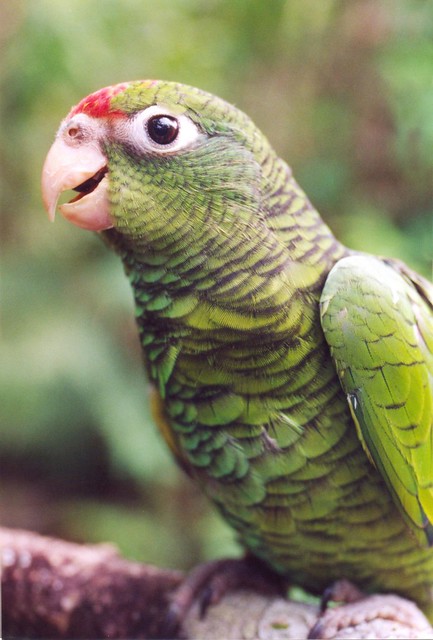Protected areas only work if they include what threatened species need
 Wednesday, September 9, 2015 at 12:56
Wednesday, September 9, 2015 at 12:56  Tucuman Parrots like this one require tree cavities and access to pino blanco seeds to successfully reproduce. Credit: L. Rivera The Tucuman Parrot (Amazona tucumana) is found only on the eastern slopes of the Andes in Bolivia and Argentina, in a region known as the Southern Yungas forest. In the 1980s, its population suffered a severe decline due to capture for the pet trade, and it has never recovered. Conservation efforts have focused on protecting swaths of Southern Yungas habitat, but new research published in The Condor: Ornithological Applications highlights the ways in which this strategy may fall short. Anna Pidgeon of the University of Wisconsin-Madison and her colleagues found that only 19% of the Southern Yungas is actually suitable breeding habitat for these parrots, and only 15% of breeding habitat is under any form of protection. Not all Southern Yungas forest is the same, and protecting habitat can only work if it includes what Tucuman Parrots actually need to successfully reproduce: tree cavities to nest in, and plenty of mature pino blanco (Podocarpus parlatorei), the evergreen trees whose seeds are the primary food for the nestlings.
Tucuman Parrots like this one require tree cavities and access to pino blanco seeds to successfully reproduce. Credit: L. Rivera The Tucuman Parrot (Amazona tucumana) is found only on the eastern slopes of the Andes in Bolivia and Argentina, in a region known as the Southern Yungas forest. In the 1980s, its population suffered a severe decline due to capture for the pet trade, and it has never recovered. Conservation efforts have focused on protecting swaths of Southern Yungas habitat, but new research published in The Condor: Ornithological Applications highlights the ways in which this strategy may fall short. Anna Pidgeon of the University of Wisconsin-Madison and her colleagues found that only 19% of the Southern Yungas is actually suitable breeding habitat for these parrots, and only 15% of breeding habitat is under any form of protection. Not all Southern Yungas forest is the same, and protecting habitat can only work if it includes what Tucuman Parrots actually need to successfully reproduce: tree cavities to nest in, and plenty of mature pino blanco (Podocarpus parlatorei), the evergreen trees whose seeds are the primary food for the nestlings.
Pidgeon and her colleagues mapped the extent of both non-breeding habitat and potential breeding habitat with pino blanco trees using data on climate and land cover. To confirm the accuracy of their maps, they conducted surveys for Tucuman Parrot along roads in the nonbreeding season and documented the locations of nests during the breeding season. Predicted suitability of habitat matched up closely with where they actually found parrots. Only about half of nonbreeding habitat was also suitable for breeding, with most breeding habitat found in Argentina.
"Despite the high proportion of Southern Yungas forest that is protected from conversion to other land cover types, our work shows that such forest protection by itself is not enough to ensure the persistence of the Tucuman Parrot," says Pidgeon. "The ecology of the parrot—what species or structures within the forest it depends on—must be taken into account, and then those elements must be adequately protected to ensure they will be available in the future. In the case of the Tucuman Parrot, the critical elements that need more conservation attention are trees with cavities, and regeneration and availability of the pino blanco, a tree that produces seeds critical to nestling survival." The researchers also found that breeding areas in Bolivia still face significant threats from poaching.
One of the most difficult aspects of the project was finding active Tucuman Parrot nests, and the research team relied on local people for help with this challenge. One, Benjamín, was particularly adept not only at finding parrot nests but at doing parrot impressions. "Every evening when the team was reunited at the camp, Benjamin would spend hours telling us every possible detail about what each of the parrots he saw did while he was searching," according to Argentine co-authors Luis Rivera and Natalia Politi. "He would imitate the parrots' sounds, imagining what they were saying, and explaining their behavior. His great observational skill not only kept us entertained, but also revealed many cues for finding cryptic nests."
"Parrots of Central and South America include many colorful species, but are also among the most threatened groups of birds due to the effects of habitat destruction and harvest of the pet trade. They are also difficult to study because they nest in tree cavities high in the forest canopy, are difficult to capture and mark, and travel long distances daily to find food. As a result, the habitat requirements for conserving most species are poorly unknown," adds Steve Beissinger, a parrot conservation expert from UC Berkeley. "I think this study nicely illustrates how to connect habitat conservation goals to specific life history needs of rare species."

